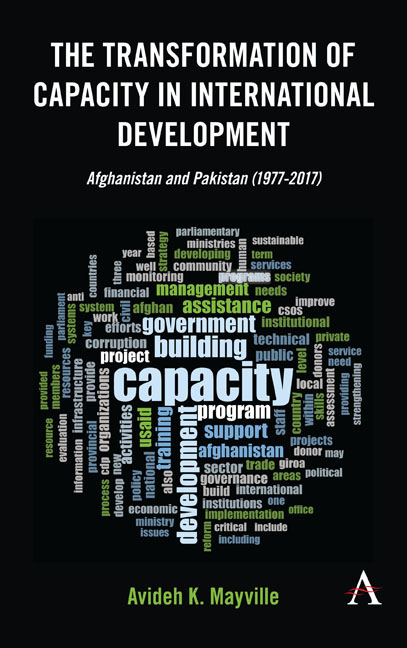Book contents
- Frontmatter
- Dedication
- Contents
- List of Figures
- Acknowledgments
- Chapter One Introduction
- Chapter Two Development Agendas and Donor Spaces: How Capacity Gained Salience
- Chapter Three Capacity in Development Policy and Practice: The Quest for Performance Excellence in the Governance of Disabling Environments
- Chapter Four Capacity and Fragility: The Sociological Framework for the Capacity Project and Developing “Fragile” States
- Chapter Five The Capacity Project in “AfPak”: Development Experiments, Subnational Spaces, and Transnational Networks
- Chapter Six The Battle for Power in Disabling Environments: Statecraft and Developing Capacity in Afghanistan and Pakistan
- Chapter Seven Developing Capacity to Manage Global Threats: Statemaking, the Militarization of Development, and Human Rights Approaches
- References
- Index
Chapter One - Introduction
Published online by Cambridge University Press: 11 December 2019
- Frontmatter
- Dedication
- Contents
- List of Figures
- Acknowledgments
- Chapter One Introduction
- Chapter Two Development Agendas and Donor Spaces: How Capacity Gained Salience
- Chapter Three Capacity in Development Policy and Practice: The Quest for Performance Excellence in the Governance of Disabling Environments
- Chapter Four Capacity and Fragility: The Sociological Framework for the Capacity Project and Developing “Fragile” States
- Chapter Five The Capacity Project in “AfPak”: Development Experiments, Subnational Spaces, and Transnational Networks
- Chapter Six The Battle for Power in Disabling Environments: Statecraft and Developing Capacity in Afghanistan and Pakistan
- Chapter Seven Developing Capacity to Manage Global Threats: Statemaking, the Militarization of Development, and Human Rights Approaches
- References
- Index
Summary
USAID often engages with governments that lack the capacity for full country ownership (my emphasis), even if there is political will to address development challenges fomenting violent extremism and/ or insurgency. In other places, capacity may exist, but demonstrated political will is lacking. Ultimately, USAID must leverage and further develop local capacity and good governance principles, such as transparency and accountability, to respond to drivers of violent extremism and/ or insurgency.— USAID Policy Task Team (PTT) publication, “The Development Response to Violent Extremism and Insurgency.” (USAID 2011a, 10)
Capacity development remains one of the most “slippery” and unsatisfactory concepts in development— “a refuge for the scoundrel,” as one colleague recently noted. There is no agreed definition, there is no formal academic body of knowledge discussing it and there are no university courses teaching it. (Tesky 2011, 44)
Introduction
Much of the aid to developing countries in recent decades has fallen under the broad umbrella of building capacity. Buzzwords such as “capacity building” and “capacity development” have permeated the development discourse and are employed in a variety of ways, typically identified as an issue, a need, and a solution to the challenges of “growth and progress.” Furthermore, the wide-ranging and all-encompassing nature of the usage of the term “capacity” obscures how exactly it is manifested in projects. For this reason, there is a need for clarification of the concept of capacity, in both its theoretical origins and the way in which it has been applied as a project of development.
With this aim in mind, this project explores a particular case of the transformation of capacity as a concept and a practice within international development, tracing the relationship between this transformation and the rise of transnational militancy in Afghanistan and Pakistan. I situate my analysis of this transformation through a close examination of the policies and projects to build capacity in these two countries between 1977 and 2017, implemented by the largest institutional donor driving them— the United States Agency for International Development (USAID).
As we near the end of the second decade in this new century, the donor community faces significant global security challenges. In spite of a concentrated so-called Global War on Terror, global terrorism continues to threaten the livelihoods of individuals, communities, and the system of states. As these security challenges become more complex, so does development.
- Type
- Chapter
- Information
- The Transformation of Capacity in International DevelopmentAfghanistan and Pakistan (1977–2017), pp. 1 - 14Publisher: Anthem PressPrint publication year: 2019

